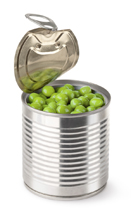Discover

iStockphoto/Thinkstock
Try This 1
Suppose you are working with a vegetable cannery to design aluminum can dimensions. You have been asked to work specifically with the volume-to-surface-area ratio. The company has asked that all cans have a height of 11.5 cm so that the cans will fit on shelves properly.
-
- Give a function, V(r), that gives the volume as a function of the radius of the can.

- Give a function, S(r), that gives the surface area as a function of the radius.

- The volume-to-surface-area ratio as a function of height can be written as
 . Expand this expression using the functions from question parts a. and b.
. Expand this expression using the functions from question parts a. and b. 
- Simplify the function R(r) by cancelling common factors, and determine any non-permissible values for R(r).

- Give a function, V(r), that gives the volume as a function of the radius of the can.
-
- Describe what happens to the volume-to-surface-area ratio as r increases and the height is kept at 11.5 cm.

- Explain how much the volume-to-surface-area ratio should influence the can dimensions selected.
- Describe what happens to the volume-to-surface-area ratio as r increases and the height is kept at 11.5 cm.
-
- r = 0 and r = −11.5 are non-permissible values for R(r). Ignoring physical limitations, explain where each of these values comes from.
- Complete a table like the following for the values near the two non-permissible values:
r R(r) r R(r) −0.1 −11.6 −0.01 −11.51 −0.001 −11.501 0 indeterminate −11.5 undefined 0.001 −11.499 0.01 −11.49 0.1 −11.4 - Explain what happens to the value of R(r) as r approaches each non-permissible value.
- Calculate the value of the numerator and denominator when R(r) is indeterminate and when R(r) is undefined. Use this information to predict the difference between an indeterminate and an undefined value.
-
- Graph
 and
and  using technology.
using technology. - Can you tell where the undefined value at r = −11.5 occurs just by looking at either graph?
- Can you tell where the indeterminate value at r = 0 occurs just by looking at either graph?
- What value does
 give for r = 0? What restriction should be placed on
give for r = 0? What restriction should be placed on  ?
?
- Graph
![]() Save your responses in your course folder.
Save your responses in your course folder.
